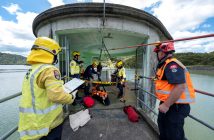While senior management has ultimate responsibility for safe work environments, it’s imperative that processes are put in place to ensure all employees understand the ways their actions can contribute to their own safety and the safety of their colleagues

After implementing your company’s safety plan you should spend time educating staff through on-going training as well as ensuring quick access to safety materials and processes at all times.
Inform Supervisor of Unsafe Conditions
Your staff are immersed in the action day in and day out, so when incidents or hazards occur they are likely first to know. Foster a culture where employees feel comfortable approaching their supervisor to alert them of hazards and ensure they are followed up quickly to maintain confidence within the workforce. Empowering staff to take responsibility and to quickly alert supervisors of unsafe conditions will make management aware of incidents faster and more efficiently. Small signs can be posted around the workplace to add as a reminder to staff for instances when a supervisor needs to be notified.
Be Fit, Sober & Alert For Work
Ensuring that employees are able to safely perform duties without being distracted or inebriated is vital to safety as well as productivity. The moment staff become unfocused, accidents can and do occur. Educate staff on the importance of only working when fit and alert and train management to communicate with employees and handle disciplinaries as needed.
Take Breaks
In an effort to be productive or increase their performance, staff may avoid taking their designated work breaks. As management, it is so important to ensure all employees get the physical and mental rest they need during each shift. Fatigue or loss of concentration can be dangerous, or even deadly, when working with machinery and equipment. Workplace wellness initiatives can help educate staff on the importance of taking mandatory breaks for their safety but also their productivity and concentration. A buzzer or bell can be used at regular intervals to remind staff that it is break time, also small signs can be posted around the workplace to serve as a prompter.
Wear Required Safety Equipment
Ensure all staff have access to appropriate safety equipment and PPE (Personal Protective Equipment) at all times such as hard hats, safety goggles, gloves or masks. Provide training to new staff and regular reminder sessions to long-standing employees on how and when to use the PPE as well as the dangers of not using the correct equipment. Staff that don’t wear required equipment pose a risk to themselves and their colleagues. Having firm policies in place for safety gear will set the expectations for staff, with adequate signage to advise staff where and when to use the PPE in the workplace for their safety.
Keep Workspaces Clean and Clear
All employees should have the responsibility to keep their work areas clean, this may vary from staff member to staff member depending on their role but there will be an expectation that everyone in the workplace maintains a high standard of organisation and cleanliness. Keeping all walkways and emergency exits and fire extinguishers free from obstruction and clutter and is essential to complying with safety regulations. Ensure all staff are aware of procedures and expectations of what they should do in the event of a spill – are they to clean spills themselves? Where are the mop and hazard signs kept? Do they call the maintenance team? Keep wet floor and caution signs available and conveniently located for staff to find. Access to a printer and labels can allow management immediate ability to alert all staff and visitors of incidents.
Use Equipment & Machines Properly
One of the most common causes of workplace injuries is due to the misuse of machines or equipment through lack of training or care. Ensure all staff are aware of how to use each piece of machinery and are regularly monitored for safety. Assess all work stations for hazards and arrange things within easy ergonomic reach to minimise potential straining. Encourage staff to discuss any equipment issues with their supervisor and promote a culture where they feel confident that their safety is a priority. While new equipment can be costly, it should be approved as soon as possible for safety, productivity and workplace confidence. In the event of machinery breaking or being unfit for use, react quickly by immediately printing labels that can be used to alert staff and keep them safe.
Charlie Holmes, Avery Product Manager, Avery Industrial Range




